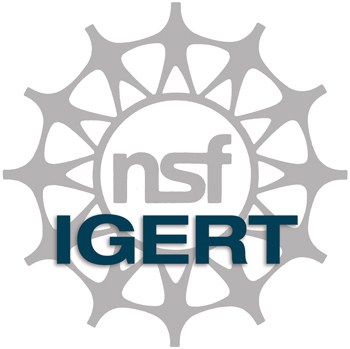
IGERT: NeuroEngineering from Cells to Systems
Providing a unique, inter-institutional neuroengineering experience with leading institutions and the latest technology
(Funded by the National Science Foundation grant 1250104 to Rice University)
Predoctoral Applications are NOT OPEN at this time – Please check back later for updates.
Program Director:
Robert Raphael, PhD, Professor, Bioengineering
Rice University
Program Administrator:
Vanessa C. Herrera, Assistant Director
Keck Center Training, Gulf Coast Consortia
Welcome to the Rice University/Baylor College of Medicine Neuroengineering IGERT!
The goal of this program is to provide students with the educational and research training needed to develop new tools to understand, interface with, model, and manipulate the nervous system. Students in our program will obtain an interdisciplinary understanding of the nervous system from the level of molecular and cellular processes to the level of information processing within neural circuits composed of millions of cells. The long term goal of this research is to develop innovative approaches to the complex challenges of restoring function to individuals suffering from disorders of the nervous system.
This Integrative Graduate Education and Research Traineeship (IGERT) award provides Ph.D. students at Rice University and Baylor College of Medicine (BCM) with innovative training in neuroengineering, spanning the disciplines of neuroscience, electrical engineering, mechanical engineering, and bioengineering. In collaboration with six other universities and participating organizations, Rice University and BCM trainees are developing the tools to understand, interface with, model, and manipulate the nervous system.
~Dr. Robert Raphael, Program Director
- Cellular Systems Neuroengineering – Will use synthetic biology, systems biology, and advanced optical imaging to understand and manipulate complex molecular and cellular signaling processes underlying the behavior of sensory cells and neurons.
- Engineering Multi-Neuron Circuits – Will develop nanofabricated electrode arrays and advanced optical imaging technology to interface with the nervous system, and sophisticated signal processing techniques to interpret the resulting complex datasets to engineer the response of multi-neuron circuits.
- Translational Neuroengineering – Will use pattern recognition, information theory, and machine learning approaches to develop new methods that better control clinical devices such as smart prosthetics and deep brain stimulators via deeper understanding of whole brain function and structure.
Neuroengineering is a rapidly emerging field that spans the traditional disciplines of neuroscience, electrical engineering, mechanical engineering, and bioengineering. Current efforts in neuroengineering are typically based on neuronal models that reduce cellular activity to an action potential, or “spike.” The spike then becomes the input to higher-order models of neuronal circuits. Therefore, the major scientific challenge is to record and analyze spike data from large numbers of neurons, and to understand how activity within these neural circuits characterizes neurophysiological substrates. Traditionally, this problem has been considered to belong in the domain of systems neuroscience, where experimental recording methods developed over the last decade have laid a foundation for the exciting development of brain-machine interfaces that can decode user intentions.
Rationale for a new approach to neuroengineering research and education. We now understand that the molecular basis of neuronal function and dysfunction can rarely be reduced to the impact of individual mutations, but rather requires an understanding of the complex network of proteins and signaling processes that determine the state of the cell. Furthermore, a complete description of cell status requires the language and tools of systems biology to integrate multi-scale biological data and to characterize systems in a way that is both quantitative and mechanistic. In addition, multicellular networks of neurons share common conceptual ground with biochemical signaling networks within the neuron. Their dynamics are nonlinear and multivariate – whether they are networks of interacting proteins, networks of membrane channels, or networks of neurons. To characterize these complex processes across multiple levels requires a clear understanding of the concepts of signal processing, feedback elements, and regulatory elements. Additionally, both neuroscientists and systems biologists face common challenges related to combinatorial complexity and high dimensionality of experimental data. The fundamental premise of our education and training program is that the neuroengineer of the future must understand and control both networks – the network within the neuron and the network beyond the neuron (Fig.1). Gaining an ability to control both networks will transform current technology and lay the foundation for optimized therapy for neural disorders.
Use and advantage of problem-based learning to teach neuroengineering. To achieve these objectives, we propose a curriculum based on problem-based learning. In these courses, students will learn neuroengineering principles not by attending a series of lectures, but instead by working through and solving complex, open-ended problems with support and guidance from their instructors.
Emphasis on innovation and introduction to technology development and commercialization. Our students are eager to identify and pursue solutions to larger societal problems, and to develop innovations that will make a positive and lasting contribution to society. The interdisciplinary field of neuroengineering offers students especially abundant possibilities for making such a contribution. Throughout the IGERT, we will use the Competitive Incentive Fund as an engine to drive students to take research beyond the level of discovery. Interactions with medical device companies and optional courses in Technology Entrepreneurship will teach students the processes and practices involved in technology development and commercialization.
Emphasis on professional development. Throughout the IGERT program, students will participate in a broad range of professional development activities. When students enter the IGERT program, they will be matched with one of the program co-investigators, who will serve as their mentor, offering them guidance not only in technical matters, but also in myriad professional development topics. Students will develop communication skills in the context of core courses, and the denouement for the IGERT program will be for students to give an hour-long talk – in the style of a TED (Technology, Entrepreneurship and Design) talk – to the IGERT faculty and students that will be publicly advertised and also available online. These professional development activities will be complemented throughout the training program in both formal ways (through course meetings, reading assignments) and informal ways (through discussions with faculty, mentors, and other students), and students will be made aware of career opportunities in academia, industry, and science policy and will be given opportunities to take electives in these areas. Furthermore, students will develop an appreciation for the global nature and context of neuroengineering research by taking a course in Global, Ethical, and Policy Considerations in Neuroengineering and by participating in international collaborations.
Applications are not open at this time.
Eligibility Requirements
U.S. citizen or permanent resident
Strong undergraduate and graduate (if applicable) GPA; excellent GRE scores
Be enrolled in one of our participating institutions/departments (See Below)
Application Checklist – Submit all items electronically to: herrera@rice.edu
Complete and submit the Application Form. Please be certain to fill out the application completely.
Attach your Project Information document to the Application form, or send it as a separate file to herrera@rice.edu.
Secure one letter of recommendation from people other than your mentor. The recommender should send their letter directly to herrera@rice.edu
Email or mail hard copies of the following items to the address below:
1. Current Resume (or Curriculum vitae) that includes previous education, honors/awards, research experiences, publications, conference abstracts
2. Copies of transcripts from ALL undergraduate and graduate institutions attended as a full-time student
3. Proof of citizenship (copy of passport, birth certificate, or permanent resident card)
To be submitted by applicant’s mentor-
Letter of recommendation on university letterhead that specifically addresses both (1) the applicant’s suitability for an interdisciplinary program bridging engineering and neuroscience; and (2) the applicant’s demonstrated commitment to advanced study in the field of neuroengineering.
All application materials must be received by (Date TBD) by mail at the address below, or by email to Vanessa Herrera (herrera@rice.edu).
Vanessa Herrera
BioScience Research Collaborative, Suite 160
6500 Main Street, MS-141
Houston, Texas 77005
IMPORTANT
Applicants must also have a completed graduate application on file with one of the participating graduate programs at Baylor College of Medicine or Rice University (listed below). Applicants who have NOT submitted an application to one of our participating graduate programs will not be considered for this IGERT program.
Baylor College of Medicine – Department of Neuroscience
Rice University – Department of Bioengineering
Rice University – Department of Electrical & Computer Engineering
Rice University – Department of Mechanical Engineering
Please contact Vanessa Herrera at herrera@rice.edu with questions about the IGERT application process. For questions about the application process to participating graduate schools, please contact the program directly.
Program Director:
Robert M. Raphael, PhD (rraphael@rice.edu)
Phone: (713)348-3494 or (713)348-3129
Location: BioScience Research Collaborative Ste. 719
Program Questions:
Vanessa Herrera (herrera@rice.edu)
Phone:(713) 348-4752
Location: BioScience Research Collaborative Ste. 160
Independent Research (RU BIOE 506) Instructor-Raphael
Sensory Neuroengineering (RU BIOE 592) Instructor-Raphael
Neural Signal Processing (RU ELEC 548) Instructor-Kemere
Current Topics in Mechanical Engineering (RU MECH 599) Instructor-TBD
Global Ethics & Policy in Neuroengineering (course under development at RU) Instructor-Raphael
Strongly Recommended:
Introduction to Neuroengineering (RU BIOE 590) Instructor-Robinson
Learning from Sensor Data (RU BIOE 575) Instructor-Baraniuk
During fellowship trainees are required to take one of the following technical electives:
Nano-Neurotechnology (RU BIOE / ELEC 680) Instructor-Robinson
Data Mining & Statistical Learning (RU STAT 444) Instructor-Allen
Bioinformatics: Network Analysis (RU BIOE 564) Instructor-Nakhleh
Physiological Control Systems (RU BIOE / ELEC 482) Instructor-Clark
Theoretical Neuroscience (RU NEUR 615)
During fellowship trainees are also required to take a course on one of the following subjects:
– Entrepreneurship
– Policy
– Professional Development
Recommended Course:
Intro to Neuroengineering (RU ELEC480/BIOE480) Instructor-Robinson
Other fellowship requirements:
– Cluster for Neuroengineering Annual Symposium (TBA) – Trainees will attend conference and participate in poster session every year of fellowship
– Keck Annual Research Conference (October 26, 2018) – Trainees will attend conference and participate in poster session every year of fellowship
– Annual IGERT retreat (2018 date TBD) – Trainees will attend and present research every year of fellowship
– Annual IGERT evaluation (Summer 2018) – participate in annual program evaluation and submit progress report and other needed verification documents
– Weekly IGERT trainee meetings – Trainees will meet weekly as part of BIOE 506 (Fall 2017 and Spring 2018) to discuss their ongoing research and promote camaraderie and a more unified cohort.
– Develop an Individual Development Plan (IDP) via your home institution or the AAAS online guide. You will not be required to submit a copy to program administration, but you will be asked to report on goal-setting and goal attainment.
– Complete Responsible Conduct of Research (NIH-approved ethics course)
Seminar and Workshop Attendance:
Trainees are required to attend one workshop and 5-10 seminars per semester. Of these, they must attend:
– Rigor and Reproducibility Workshop, TBA
– Two (2) Keck Seminars (minimum of 2 required)
– Three (3) BCM Neuroscience Seminars (minimum of 3 required)
– Rice Bioengineering Seminar Series (no minimum required)
– Rice Electrical & Computer Engineering Seminar Series (no minimum required)
– UT Neurobiology & Anatomy Seminar Series (no minimum required)
*NOTE: Some seminars and poster presentations at local conferences will be designated as required as opportunities present themselves as part of BIOE 506.
Outreach:
Outreach experience through BrainStem (a project led by Rice faculty)
Rice Neuroscience Society (a student-run and organized group)
Trainees are welcome to recommend other neuroscience-related community outreach projects to fulfill this requirement.
Principal Investigator
Robert M. Raphael, Rice Bioengineering: Auditory bioengineering
Steering Committee
Robert Raphael, PI
Behnaam Aazhang, co-PI
Dora Angelaki, co-PI
Caleb Kemere, co-PI
Marcia O’Malley, co-PI
Xaq Pitkow
Jacob Robinson
Amina Qutub
Co-PIs
Dora Angelaki, Baylor College of Medicine, Neuroscience: Somatosensory integration
Marcia O’Malley, Rice, Mechanical Engineering: Neurorobotics
Behnaam Aazhang, Rice, Electrical and Computer Engineering: Information theory
Caleb Kemere, Rice, Electrical and Computer Engineering: Neural interfacing
Baylor College of Medicine Department of Neuroscience Researchers
William Brownell, Hair cell and efferent neurophysiology
Fabrizio Gabbiani, Sensory information processing
Andrew Groves, Genetics, hair cell development
Xaq Pitkow, Computational Neuroscience
Andreas Tolias, Neocortical circuits
Rice University Researchers
Genevera Allen, Statistics: Data mining
Rich Baraniuk, Electrical and Computer Engineering: Signal processing
Janice Bordeaux, Psychology: Educational assessment
Steve Cox, Adjunct Faculty, Computational and Applied Math: Computational neuroscience
Michael Diehl, Bioengineering: Cellular imaging
Herbert Levine, Bioengineering: Physical biology
Amina Qutub, Bioengineering: Systems biology
Jacob Robinson, Electrical and Computer Engineering: Nanofabrication
Ann Saterbak, Adjunct Faculty, Bioengineering: Problem-based learning
Jeff Tabor, Bioengineering: Synthetic biology
- Fall ’18 – The Cluster for Neuroengineering Annual Symposium will be October 12, 2018, at the BioScience Research Collaborative, 6500 Main Street, Houston.
- 2018 IGERT retreat, Summer 2018 (Date, TBD);
Current IGERT Trainees (2017-2018):
 Krishna Badhiwala (Bioengineering Department, Rice University)
Krishna Badhiwala (Bioengineering Department, Rice University)
Mentor: Jacob Robinson, PhD
Title: Scalable Microdevices for Neuroscience with Small Organisms Small organisms such as Hydra provide a useful model for studying the nervous system.
Project Summary: These transparent invertebrates can be manipulated in microfluidic chambers to image almost every neuron. Neuronal calcium imaging combined with electrophysiology provide the resolution needed to identify single action potential events and the individual neurons associated with observed animal behavior. This project aims to study the neural processes underlying animal behavior using small model organisms in a microfluidic platform.
 Madeline Burns (BioSciences Department, Rice University)
Madeline Burns (BioSciences Department, Rice University)
Mentor: Julia Saltz, PhD
Title: Individual Differences in Decision Making and Learning.
Project Summary: Understanding how and why individuals differ in learning is important, both for generating predictive models of how previous experience may impact future decision making, as well as informing how neurological therapies may be tailored to the individual. My project focuses on how critical early stages of learning (such as differences in how individuals encounter, perceive, and respond to stimuli in their environment) contribute to variation. Comparing two different species (Drosophila simulans and D. sechellia), I am investigating how differences in willingness to explore a novel environment and strength of preference influence learning ability. This study will provide novel insight into how factors such as personality and preference influence the learning process to generate consistent individual variation.
 Joshua Chu (Electrical & Computer Engineering Department, Rice University)
Joshua Chu (Electrical & Computer Engineering Department, Rice University)
Mentor: Caleb Kemere, PhD
Title: Probing Mechanisms of Working Memory and Decision Making Through Manipulation of Hippocampal Circuits.
Project Summary: My research will investigate the incorporation of information from hippocampal replay into working memory and decision making. Real time decoding of replay events and content-based perturbation of associated sharp wave ripples (SWRs) will help deepen our understanding of the contribution of replay to learning and memory processes. This study may have translational impact by revealing strategies for treatment of depression or posttraumatic stress disorder via selective replay suppressions that do not interfere with recall of other memories.
 Hamin Jeon (Bioengineering Department, Rice University)
Hamin Jeon (Bioengineering Department, Rice University)
Mentor: Tomasz Tkaczyk, PhD
Title: Minimally Invasive High Resolution Imaging of Auditory Neurons Inside a Living Cochlea.
Project Summary: I propose to develop a minimally invasive cochlear‐imaging device, based on the fast Image Mapping Spectrometer (IMS). Overall, the proposed research plan will involve development of innovative tool that can shed more light onto the elaborate workings of hair cells and auditory neurons in cochlea and, ultimately, the mechanisms of sound transduction. This may lead to the development of new treatments for hearing loss, or improvement of existing treatment technologies such as cochlear implants.
 Colin Noe (Psychology Department, Rice University)
Colin Noe (Psychology Department, Rice University)
Mentor: Simon Fischer-Baum, PhD
Title: Analyzing Human Speech Perception with EEG.
Project Summary: I use EEG to study the neural and cognitive mechanisms underpinning speech perception in humans. Specifically, in our lab, we study an early EEG waveform, the N1, to index the process of phonemic perception (how parts of word sounds are identified). By measuring speech perception with EEG, we can index the various attributes of the neural representation of speech in real time. This allows us to explore cognitive questions such as: Are the processes indexed by the N1 speech specific or are they shared with other auditory domains? Does top-down information influence phonemic judgments as those judgments are occurring (and thus alter the N1 in some detectable way), or does top-down information get integrated after the N1-processes have occurred? Our exploration of these questions integrates classic ERP approaches and novel machine learning techniques to decode which types of information are available in the N1 waveform.
 Matthew Evan Pezent (Mechanical Engineering Department, Rice University)
Matthew Evan Pezent (Mechanical Engineering Department, Rice University)
Mentor: Marcia O’Malley, PhD
Title: Design and Control of a Robotic Exoskeletal Device for Hand-Wrist Rehabilitation.
Project Summary: Robot-augmented therapy is a clinically verified path forward to improving rehabilitation outcomes for several neuromuscular conditions, such as stroke and spinal cord injuries. Robotic rehabilitative devices enable the high intensity, long duration interventions needed for regaining motor function, and quantitative metrics for tracking therapeutic outcomes. I am developing a combined hand-wrist robotic exoskeleton to research passive dynamics in the hand and wrist during grasping and manipulation, and then mimic such properties in collaboration with stroke rehabilitation clinicians.
 Ankit Raghuram (Electrical and Computer Engineering Department, Rice University)
Ankit Raghuram (Electrical and Computer Engineering Department, Rice University)
Mentor: Ashok Veeraraghavan, PhD
Title: A computational framework for categorizing the depth limit of bioluminescent sources in scattering media.
Project Summary: Bioluminescence has recently been considered as a modality to image through scattering brain tissue because of its high signal-to-noise ratio as compared to other imaging techniques like fluorescence. I am creating a framework to compute the resolution and depth limit of bioluminescence in scattering media by modeling photon trajectories using a Monte Carlo simulation as a means of estimating whether it is possible to resolve bioluminescent sources at common imaging depths for scattering media. Future work will focus on using this framework to test different parameters of bioluminescence like emission rate and different distributions of background. Knowing these limits of bioluminescence will give scientists designing bioluminescent molecules a goal to strive towards in order to image groups of neurons at particular depths.
 Dan Sazer (Bioengineering Department, Rice University)
Dan Sazer (Bioengineering Department, Rice University)
Mentor: Jordan Miller, PhD
Title: Spatially Controlled Photo-Patterning of Multi-Material Sensory Organ Mimics.
Project Summary: The histological architectures of mammalian sensory organs are complex and heterogeneous. Integration of discrete cellular layers allows these tissue systems to reliably sense and relay environmental stimuli, but there does not currently exist a fabrication platform that is capable of recapitulating and probing these heterogeneous organs in vitro. The central objective of this study is to use projection stereolithography (PSL) to pattern multi-material, cell-laden hydrogel constructs that mimic the heterogeneous organization of sensory tissue systems such as the retina and cochlear stria vascularis. I am developing a novel 3D printer that implements PSL for cyto-compatible, multi-material integration, and with this system I intend to fabricate sensory organ mimics for various functional and pathological assays.
 Sudha Yellapantula (Electrical & Computer Engineering Department, Rice University)
Sudha Yellapantula (Electrical & Computer Engineering Department, Rice University)
Mentor: Behnaam Aazhang, PhD
Title: Analyzing human brain dynamics during language tasks from ECoG data, using information theoretic tools and graph theory.
Project Summary: The human brain is a highly interconnected set of neuronal pathways, and the overarching goal of this project is to analyze macroscopic brain network dynamics during language tasks, from ECoG recordings. Information theoretic connectivity metrics like mutual information in frequency, and directed information are used to infer dependencies and information flow between brain regions. To make holistic inferences at a macroscopic scale, graph theoretic tools are used to combine network information from multiple frequency bands across time, to reveal novel patterns and shed more light on the functional connectivity patterns in the human brain during a specific language task.
 Joseph Young (Electrical & Computer Engineering Department, Rice University)
Joseph Young (Electrical & Computer Engineering Department, Rice University)
Mentor: Behnaam Aazhang, PhD
Title: Discovering the Neurophysiology of Visual Skill Learning.
Project Summary: Despite numerous years of research on skill learning, incredibly little is understood about the neuronal explanation for why skills develop with practice. Initial research focused on single neuronal changes and yielded minimal insight. In order to truly address this question, I am analyzing neuronal interactions at the network level using recordings from rhesus macaques learning a visual task and developing data-driven approaches for such analysis. This involves the use of probabilistic metrics from information theory that can capture nonlinear interactions, such as mutual information, both in time and frequency. These tools will allow me to develop insight into the neurophysiological changes accompanying and underlying learning without imposing models.
 James Webb (Neurology Department, Baylor College of Medicine)
James Webb (Neurology Department, Baylor College of Medicine)
Mentor: Caleb Kemere, PhD
Title: Deep Reinforcement Learning Models of Spatial Representation and Memory in Animals.
Project Summary: Deep reinforcement learning has led to drastic technological advances in recent years, but understanding how artificial systems learn and perform tasks often remains elusive. Similarly, while neural activity in the hippocampus and adjacent structures has been well-documented, including the presence of place cells and grid cells, many questions remain about the roles of specific structures. Combining these deeply linked fields, this project aims to build neurally-inspired artificial neural networks that can perform visuospatial tasks. We wish to improve performance by modeling biological networks, which, in turn, may provide insight into the mechanisms of their underlying circuitry.
Click here to print Current Trainees’ project descriptions.
Previous IGERT Trainees:








